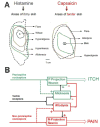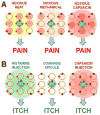Sensory neurons and circuits mediating itch
- PMID: 24356071
- PMCID: PMC4096293
- DOI: 10.1038/nrn3641
Sensory neurons and circuits mediating itch
Abstract
Chemicals that are used experimentally to evoke itch elicit activity in diverse subpopulations of cutaneous pruriceptive neurons, all of which also respond to painful stimuli. However, itch is distinct from pain: it evokes different behaviours, such as scratching, and originates from the skin or certain mucosae but not from muscle, joints or viscera. New insights regarding the neurons that mediate the sensation of itch have been gained from experiments in which gene expression has been manipulated in different types of pruriceptive neurons as well as from comparisons between psychophysical measurements of itch and the neuronal discharges and other properties of peripheral and central pruriceptive neurons.
Figures







References
-
- Chen SC. Pruritus. Dermatol Clin. 2012;30:309–321. - PubMed
-
- Kuraishi Y. Potential new therapeutic targets for pathological pruritus. Biol Pharm Bull. 2013;36(8):1228–34. - PubMed
-
- Hägermark O, Strandberg K, Grönneberg R. Effects of histamine receptor antagonists on histamine-induced responses in human skin. Acta Derm Venereol. 1979;59:297–300. - PubMed
Publication types
MeSH terms
Grants and funding
LinkOut - more resources
Full Text Sources
Other Literature Sources
Medical
Research Materials

